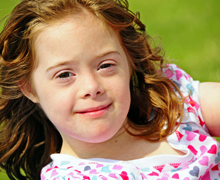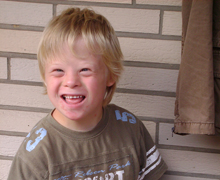By Mary O’Callaghan | It’s tempting to make neat calculations based on what we know in the abstract about Down syndrome. But once an actual child enters into the equation—with all of his strengths and foibles, quirks and habits—we don’t get the answer we expected at all.
As Ohio considers a bill that would outlaw abortions following an in utero diagnosis of Down syndrome, Mark Schrad, a political science professor at Villanova University, has taken to the pages of the New York Times to speak against it. Schrad’s voice carries weight because he and his wife received a diagnosis of Down Syndrome eight years ago for their unborn daughter—and chose to welcome her into their family.
I, too, have an eight-year-old child with Down syndrome—a sweet, funny, energetic little boy—but I disagree with Schrad. In fact, I recently testified in favor of similar legislation before a Senate committee hearing in Indiana.
In the discussion of the joys and the struggles of raising a child with a disability, it can be easy to resort to one-dimensional portrayals, especially when the discussion includes talk of abortion. We all know how much is at stake here.
Schrad and other opponents of the Ohio bill paint horror stories of the excruciating burden that the legislation will place on families. These are scare tactics. In fact, they don’t differ much in tone from the grim portraits given by physicians. On the other hand, proponents of the legislation emphasize the positive features of life with a child with Down syndrome, but they risk sounding unrealistic and indifferent to the suffering that some families experience.
There is no easy calculus for weighing the joys and the struggles associated with raising any child, let alone a child with a disability. When we are given a prenatal diagnosis, it’s tempting to make neat calculations based upon what we know in the abstract about Down syndrome; but once the actual child enters into the equation, with all of his strengths and foibles, quirks and habits, not to mention that surge of parental love that comes unbidden, we don’t get the answer we expected at all, but one that defies calculative reason.
Given the uncertainty in predicting how any of our children will affect our well-being, it may be worth considering other criteria for evaluating legislation such as the Ohio bill. Jerome Lejeune, the French geneticist who discovered the chromosomal basis for Down syndrome, offers this perspective: “It cannot be denied that the price of these diseases is high—in suffering for the individual and in burdens for society. Not to mention what parents suffer! But we can assign a value to that price: It is precisely what a society must pay to remain fully human.”
Do Birth Defects Change the Morality of Abortion?
Schrad suggests that the Ohio bill was passed without a thorough understanding of the complexities of the abortion issue within the disability community, wherein “conventional social dynamics around abortion are completely reversed.” In Schrad’s portrait of a through-the-looking-glass disability world, strident pro-choice advocates may choose to bear children with Down syndrome while pro-life conservatives sometimes abort their offspring with an extra chromosome.
That this happens I don’t doubt. What is problematic is the suggestion that issues involving disability present a unique arena for questions of the morality of abortion and the political discourse that go along with it. The implication is that traditional understandings of the abortion issue are no longer relevant and conventional political mores are so upended that this area defies legislative action. According to this logic, the Ohio bill and others like it are problematic because they will satisfy neither disability activists, some of whom may be pro-choice, or pro-lifers, some of whom may have aborted their child with an extra chromosome.
But this issue is not as complex or difficult to navigate as Schrad would like us to think. First, his contention that “you’re likely to find many strident pro-life conservatives opting for abortion in the face of such challenges,” whether true or not, has little bearing on the Ohio bill or the issue behind it. Schrad concedes that the people he describes are not hypocrites, but reacting to a difficult situation. What he fails to do, however, is offer a reasoned account of the relation of this phenomenon to legislation. It is no surprise that actions under duress are not consistent with professed moral views. Hard cases make bad laws, and an ex post facto justification of abortion after parents have undergone the harrowing diagnostic process that Schrad describes is hardly a good criticism of the Ohio bill. Good laws come not from considering behavior under stress, but from a reasoned consideration of what is right and just.
Pro-Choice Parents
The apparent paradox that Schrad describes—the existence of pro-choice parents of children with disabilities—occurs because chromosomal variation in children cuts across the political party and pro-choice/pro-life lines of parents. Both sides bear offspring with Down syndrome, either unwittingly or by choice. There is nothing about being personally pro-choice that precludes carrying a child with Down syndrome to term, if one desires, and not all pro-choice women undergo prenatal testing. So it is not at all surprising to find that Down Syndrome advocacy groups, comprised mainly of parents, are often split along traditional pro-life and pro-choice lines.
What may be surprising is that this split was not apparent earlier. In 2007, the recommendation of the American College of Obstetricians and Gynecologists (ACOG) that prenatal testing should be offered to all pregnant women was generally perceived by parental advocates as a specific effort to root out the lives of children with Down syndrome. In the beginning, these advocates came together in a unified fashion. Their grassroots lobbying efforts led to the bipartisan Kennedy-Brownback Act, the purpose of which was to ensure that accurate information be provided to parents who received a prenatal diagnosis.
However, as similar legislative efforts moved to the state level, and local advocacy groups hammered out details, division arose in the Down syndrome community over such issues as whether abortion should be mentioned as a choice in informational brochures, as well as whether to pursue bans on abortion or simply mandate better information. It is worth noting that the original concern with mentioning abortion in such materials came from self-advocates with Down syndrome. It is not difficult to understand why.
The split within the community, however, did not arise as a result of anything unique to the disability community. On the contrary, it reflected parents’ pre-existing and strongly held views on abortion prior to having a child with Down syndrome. Even Schrad makes his and his wife’s views clear, describing himself and his wife as “ardent pro-choice advocates.” Their child’s diagnosis and her subsequent birth did not affect their pre-existing pro-abortion stance. So there’s no complexity here. The disagreement in the disability community over abortion simply reflects the abortion divide in our country writ small.
Taking Away Choice?
Schrad also complains that the Ohio bill takes away choice. All legislation takes away choice, in some respect, and limits even “deeply personal ethical and social decisions.” However, in the case of abortion after a prenatal diagnosis, the choice that Roe v. Wade meant to protect is still protected. Most children with Down syndrome were “wanted” children, for lack of a better term, until their parents learned of their disability. But, as a 2013 amici curiae brief in a case banning late-term abortion in Arizona pointed out:
this Court has never endorsed a right to abort children only because they have been detected to have a disability. In Planned Parenthood v. Casey . . . this Court repeatedly premised its reaffirmation of abortion rights in terms of the right to terminate an unintended pregnancy.
Roe v. Wade was never intended to open the door to aborting infants because of prenatally diagnosed disabilities.
The rhetoric of choice belies the fact that women often do not make truly free and autonomous choices in the case of prenatal diagnosis. On the contrary, they are often pressured and even indirectly coerced to abort their children. Schrad himself describes his and his wife’s choice to keep their daughter as something they had to “fight for,” which implies considerable opposition and tacit coercion. This medical and social pressure, which has persisted even in the face of federal and state laws requiring that accurate information be provided to parents, is also clear in other anecdotal reports as well as some preliminary quantitative data. Schrad and his wife were strong enough to withstand this pressure; not surprisingly, many parents buckle under it. Clearly, this indicates a need for stronger legislation and enforcement.
Resources for Families of Children with Down Syndrome
Schrad’s final criticism is that resources are not in place to support the children who would otherwise be aborted if laws such as the one in Ohio become reality. As a parent of a child with multiple medical problems, I sympathize with parents who worry about increased financial burdens.
However, recent research has suggested that parents of children with Down syndrome pay, on average, an additional $84 per month in out-of-pocket medical expenses. While not negligible, this figure does not constitute the “tremendous medical and financial burden” that Schrad suggests is characteristic of having a child with Down syndrome, nor does it justify his prediction of widespread bankruptcies. Medical costs are highest in the first year of life, and tend to decrease with age. I have seen enough wasted state Medicaid funds to know that a more efficient use of monies in this vulnerable early period could accommodate more children in the system.
Certainly, there are other costs, both personal and social, of having a child with a disability. But even here, research points to a generally positive experience of parenting a child with Down syndrome. A large scale longitudinal study of over 100 families reported more positive effects of having a child with Down syndrome than negative, and recent research shows that over 90 percent of individuals with Down syndrome, and their parents, are happy with their lives.
Despite the increasingly positive data about Down syndrome, somewhere between 70 and 90 percent of parents who receive this diagnosis choose abortion. I testified in Indiana, not because we are on a slippery slope, but because once we accept abortions based solely on disability, we are already at the bottom.
If you found this blog post of interest, you might want to explore these Free Think University courses:
- Are Human Beings Just Animals?
- Pro-Life, Pro-Choice, or Something Else?
- Should Assisted Suicide Be Allowed?
For this third party post in its full context, please go to:
Joys, Struggles, and Scare Tactics: On Down Syndrome and Abortion
© 2015. The Public Discourse. www.thepublicdiscourse.com



